Youth participation in the restoration of socio-ecological production landscapes and seascapes (SEPLS) towards sustainability in oceanic islands - Penghu
13.04.2023
SUBMITTING ORGANIZATION
Soil and Water Conservation Bureau, Council of Agriculture Executive Yuan
OTHER CONTRIBUTING ORGANIZATIONS
National Chung Hsing University, R.O.C. (Chinese Taipei),
Taiwan Environment Greenery Association, R.O.C. (Chinese Taipei)
DATE OF SUBMISSION
27/03/2023
REGION
Asia
COUNTRY
Chinese Taipei
KEYWORDS
Penghu islands; stone weir; natural protection; youth participation; sustainable development
AUTHORS
Chen-Yang Lee1, Kuei-Lin Fu2, Chen-Fa Wu3*, Luu Van Thong Trac3*, Szu-Hung Chen4*, Ling-Tsen Chen1, Jui-Min Chu2, Chuang-Chin Cheng2, Chien-Hung Tsai2, Hao-Yun Chuang1, Chun-Hsien Lai5, Ming-Ju Lee6, Chen-Ju Wang7, Chun-Chief Hu8, Hsi-Chun Chen1, Hao-Wei Hsu5, Ting-Yu Lin5
- Soil and Water Conservation Bureau, No. 6, Guanghua Road, Nantou City 540, R.O.C (Chinese Taipei)
- Soil and Water Conservation Bureau Tainan Branch, No. 316, Section 1, Linsen Road., East District, Tainan City 701017, R.O.C (Chinese Taipei)
- Department of Horticulture, National Chung Hsing University, No. 145, Xingda Road, South District, Taichung City 402, R.O.C (Chinese Taipei)
- International Master Program of Agriculture, National Chung Hsing University, No. 145, Xingda Road, South District, Taichung City 402, R.O.C (Chinese Taipei)
- Taiwan Landscape Environment Association, 10F, No. 118, Mingcheng 2nd Road, Sanmin District, Kaohsiung City 80794, R.O.C (Chinese Taipei)
- Department of Tourist and Leisure, National Penghu University of Science and Technology, No.300, Liuhe Road, Magong City, Penghu County 880011, R.O.C (Chinese Taipei)
- No. 28-3, Hudong, Huxi Township, Penghu County 885001, R.O.C (Chinese Taipei)
- Department of Marine Sports and Recreation, National Penghu University of Science and Technology, No.300, Liuhe Road, Magong City, Penghu County 880011, R.O.C (Chinese Taipei) *Corresponding: Chen-Fa Wu (cfwu@dragon.nchu.edu.tw), Luu Van Thong Trac (thongtracluuvan@smail.nchu.edu.tw), Szu-Hung Chen (vickey@dragon.nchu.edu.tw)
Summary Sheet
The summary sheet for this case study is available here.
Summary
The Penghu Islands, situated in the Taiwan Strait, boast a diverse array of marine life and a unique cultural heritage. Recognizing the significance of these landscapes, the local government and several organizations have collaborated to implement a series of initiatives to restore and promote sustainable management practices in the socio-ecological production landscapes and seascapes of this region. Human activities and natural systems interact to produce goods and services, such as fishing methods (e.g., using stone weirs). The restoration and sustainable management of socio-ecological production landscapes and seascapes in the Penghu Islands are critical for protecting biodiversity, maintaining essential ecosystem services, and preserving local livelihoods and cultural heritage. The active involvement of the young generation in these endeavors is of particular importance, which is being encouraged and supported to ensure the long-term viability and success of such initiatives. By engaging youth in these efforts, we can cultivate a new generation of environmental stewards who will work towards safeguarding the planet’s natural resources and cultural heritage for future generations. Therefore, youth participation is not just essential but a fundamental pillar for ensuring the success of these initiatives in the long run. Overall, the effort to engage youth in the restoration and sustainable management of the Penghu Islands serves as a model for the role that young people can play in promoting sustainable development and preserving natural and cultural resources for future generations.
Background of Penghu Islands
The climate of Penghu Island is windy and dry, and it is roughly located on the Tropic of Cancer. The annual average temperature is 23°C, with the lowest average temperature of 16.2°C in February and the highest average temperature of 28.3°C in July (the Central Meteorological Bureau, 2022). The rainfall concentrates in summer, with an average annual rainfall of about 1200 mm; however, evapotranspiration is higher than the rainfall. Since no rivers are on the surface, it is challenging to maintain the freshwater supply. The island experiences strong monsoons, with high wind speeds and salt spray that harm crops and trees. The average wind speed from October to November is 6.7m/sec, while the maximum wind speed ranges from 9.7-12.2m/sec on an annual average (Penghu County Government, 2023).
Penghu Island is located in the Taiwan Strait, between mainland China and Taiwan Islands, and covers an area of 126.864 square km. It is characterized by its rich volcanic geological landscapes, including siliceous basalt and alkaline basalt rocks formed by historical volcanic activities. Siliceous basalt is primarily located in the center of the main eruption area, while alkaline basalt is distributed around it. The soil is weathered from primary basalt. The main components are red soil of anorthite and pyroxene. It contains iron nodules, and the organic matter content is very low in soil stability. Most of the soil contains salt, and the climate with little rain reduces the fertility of the soil, and the agricultural productivity is also low. On land, the terrain is flat, with minor ups and downs, and no mountains exist. The highest point is 79 meters above sea level. The lack of mountains on Penghu Island means that the local area cannot capture water vapor, resulting in a reliance on the ocean to regulate surface temperature and form convective rain. This lack of permanent rivers also limits the development of agriculture, as it must rely on groundwater or pond irrigation for irrigation (National Penghu University of Science and Technology, 2016; Wu, 2021). The exposed basalt rocks on the island provide readily available materials. Fragmented basalt rocks can be used for building walls, and plate-shaped basalt rocks can be used as paving stones, which have become an indispensable part of residents’ lives.
The coastal areas of Penghu Island are shaped by the impact of waves, coastal currents, and tides, resulting in a variety of rich volcanic geological and coastal terrain landscapes. These include erosive sea cliffs, erosion platforms, arches, caves, and cliffs created by the erosive power of the sea. Penghu Island’s intertidal zone covers an area of 164.1 square km, and the tidal range is about 3 meters due to the flat platform provided by the basaltic magma. The presence of gravel creates a diverse habitat environment with high biodiversity, as it provides enough space for intertidal organisms to survive. The different coastal terrains in the intertidal zone give rise to different biological communities of organisms. It is home to a variety of animal species including shellfish, crustaceans, echinoderms, corals, and fish, making it an important source of biological resources (Penghu County Government, 2023). There are approximately 120 known species of corals, including stony corals, soft corals, horned corals, and hydro corals, providing biological habitats and nutrients. The remains of coral reefs become natural building materials after sedimentation and cementation (Wu, 2021). These solidified stones are utilized by local residents to construct stone walls and homes.
Three ocean currents are flowing through the Taiwan Strait through Penghu Island. The first among them is the cold current, which has its origin in the northern part of the Yellow Sea and moves southwards along the coast of China, affecting the waters to the west of Penghu. During the summer, the impact of the southwest monsoon causes the current to weaken, whereas the influence of the northeast monsoon in winter enhances its strength, resulting in sea water temperatures that are lower than those of the Kuroshio Current. Consequently, fish swim southward along with the current and gather on the western side of Penghu. The mainstream of the second Kuroshio Current goes north along the west coast of Taiwan and reaches the sea area of Penghu. In winter, the northeast monsoon has caused most of the current to flow towards the South China Sea. A minor portion enters the Taiwan Strait and flows north to the Penghu region. In the summer, the southwest monsoon strengthens the current. The high seawater temperature and salinity attract fish species from the tropical Pacific and Indian Oceans. Third is the South China Sea monsoon flow. In the summer, Penghu experiences a significant impact from both the tributary of the Kuroshio Current and the South China Sea monsoon flow. In winter, it is heavily influenced by the cold current along the coast of China. In conclusion, the convergence of various warm and cold ocean currents in Penghu creates a plentiful supply of plankton, making it an ideal habitat for many fish species (Penghu County Government, 2023).
Socioeconomic and environmental characteristics of the study area
Population
The research area includes Nanliao Township, Hudong Township, Huxi Township, Hongluo Township, and Qingluo Wetland in Huxi Township, Penghu County, with an area of about 7.63 square kilometers. The terrain of the study area is high in the south and low in the north, with a slight elevation difference. The average slope is only about 12%, and the average elevation is 30 meters. Regarding population, Huxi Township has the largest population of 1,379, while Hudong Township has a minor population of 400. There has been a slightly positive growth trend in the past ten years. The proportion aged 0-19 is about 13.36 %, that of 20-39 is about 29.78%, that of 40-65 is about 35.5%, and that of people over 65 is 19.84% (Penghu County Government, 2023).
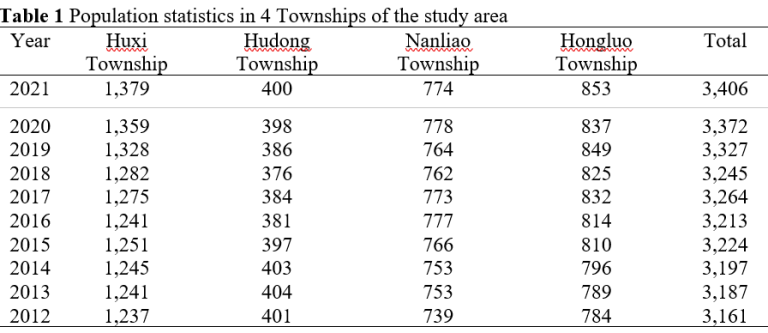

Plants
A survey conducted in the vicinity of Hongluo Township recorded the presence of 90 families and 315 species of vascular plants. Of these, 68 families, 174 genera, and 229 species belong to dicotyledonous plants. 15 families, 56 genera, and 77 species are monocotyledonous plants. Additionally, the survey found 4 families, 4 genera, and 5 species of gymnosperms, as well as 3 families, 3 genera, and 4 species of ferns (Penghu County Government, 2023).
The dominant flora in the area consists of four types: mangrove flora, where the main species are penzai, sea eggplant, olive plum, and red sea olive; coastal and fish farm afforestation flora, dominated by white Mizuki (Pittonia chinensis) and Small-leaved monkey puzzle tree (Araucaria chinensis) among others; coastal vegetation, which is mainly composed of salt-tolerant and wind-resistant plants such as sea hibiscus, bitter forest pan, Yanding, saddle vine, and cactus; and grassland vegetation, dominated by Mengren Grass, celestial chrysanthemum, and ink cabbage.
Birds
In the study area, 65 bird species are found in 22 families. Sandpiperidae has the highest number of species with 14, followed by Heronidae and Lallidae with 9 species each. Some of the conservation bird species found in the area include the black-faced spoonbill, swallow-tailed plover, tang egret, red-bellied hawk, gray-faced vulture, kestrel, osprey, red tern, lesser tern, gray tern, and red-tailed shrike. The coastal waters of the area are known to be clovefish fishing grounds, and a large number of terns forage in the sea area during early summer. Little terns breed in the dune terrain of the coastal area (Penghu County Government, 2023).
Fish
According to the survey conducted by the Penghu Marine Biology Research Center, 159 fish species in 59 families were found. The dominant families include Gobiidae with 10 species (6.3%), Trevalidae and Snapperidae with 8 species each (5.0%), flying fishes and scorpionidae with 7 species (4.4%) of each, and Filiaceae with 6 species (3.8%). The main dominant fish species, including Japanese water skies, black-tailed sardines, short-nose stalked dogfish, mullets, and Aonei drill mouth, account for 72.8% of the total species (Penghu County Government, 2023).
Decapods
According to the survey of Qingluo Wetland by the National Penghu University of Science and Technology in 2011, there are 62 species in 16 families, and the biodiversity is quite rich such as Ocypodidae, Portunidae, Grapsidae, Xanthidae, Diogenidae, etc. (Penghu County Government, 2023).
Shellfish
According to the 2018-2019 Qingluo Wetland shellfish survey results, 84 families and 231 species were recorded in the three classes of Polyplacophora, Gastropoda, and Bivalvia; 169 species in 65 families and 59 species in 17 families of Bivalvia. Dominant species include Batillaria sordida, B.zonalis, B. zonalis; Clypeomorus batillariaeformis, Clypeomorus batillariaeformis; Isognomon nucleus, Isognomon nucleus; Littoraria undulata corrugated corn snails; Lunella coronata pearl snails of the snail family; Monodonta ladio straw mat bell snails of the family Snail family; Nerita albicilla fishing boat snails, N. costata black rib snails, N. plicata burley Snail (Penghu County Government, 2023).
The findings of the biological survey reveal that the level of diversity among terrestrial plants in the examined area is relatively modest. The bird species observed predominantly exhibit migratory behavior, while the fish species show similar patterns, with populations fluctuating in response to seasonal and oceanic currents. Furthermore, the shellfish and crustacean populations display seasonal and oceanic current-dependent variations. The intertidal microhabitats within the area exhibit substantial diversity, resulting in variations in the distribution of species.
Description of human-nature interactions in the area
1. Traditional fishing methods in the intertidal zone
Despite the challenging climate and ocean currents, the intertidal zone in the Penghu area has developed a unique fishing technique using stone weir to catch fish. This traditional fishing method, known as the “stone weir”, has been in use for approximately 250 years. The number of stone fish weirs has gradually increased over time, with 69 recorded in 1915, 314 in 1917, 284 in 1938, 192 in 1957, 558 in 1999 (Hong, 1999), and 592 in 2008 (Li, 2008). These features demonstrate the durability and effectiveness of the stone weir fishing method in the intertidal zone between the Penghu Islands of Taiwan.
2. Site selection for stone weir construction in the intertidal zone
According to (Hong, 1999), the stone weir is a trap fishing method used in the intertidal zone. There are four essential elements required for its construction, which are as follows:
(A) Availability of suitable stone materials: Along the coast, rocks or boulders are necessary for building the embankment. Basalt is the preferred material for the outer layer of the embankment, while coral stone, a type of coral reef limestone, is used for the inner layer. Coral stone has the unique property of decomposing into calcium bicarbonate in the presence of acid rain, which helps to fill in any cracks in the pile of basalt rock and consolidate the structure.
(B) Workable tidal range: To ensure effective fish collection in a stone weir, the tidal range plays a crucial role. A significant tidal range is preferred as it allows the tide to carry fish into the pools during high tide. As the tide recedes, the water level in the pools remains higher than the sea level, leading to the entrapment of fish within the pools. Therefore, a larger tidal range leads to a more efficient fish collection effect.
(C) Strong wind and waves: The worse the weather, the stronger the waves and the easier it is for fish to be driven into the pool. In Penghu, except for the southerly wind from June to August, there are more northeasterly winds during the rest of the year, resulting in high wind speeds and a higher frequency of windy days. When the wind is strong, the waves become more extensive, making it easier to trap fish in the pools. As a result, the stone weir typically catches more fish during winter when strong winds prevail compared to summer.
(D) Presence of a significant reef shed: One more essential element required for the successful construction of a stone weir is the presence of a significant reef shed. The shallow coral flat should be wide enough, and the seabed should have a relatively gentle slope to facilitate the construction of the weir.
Stone weirs are typically built in an arc-shaped design, with walls constructed from stacked stones 1-3 meters high. This design is necessary to withstand the various changes in wind, waves, and tides. The end of the wall is often bent into a spiral shape, and a fish-collecting wall may be added for more complex structures. These stone walls are often equipped with doors, ladders, teeth, fish wells, and narrow areas tailored to fishing needs. In some cases, several houses may be built to serve as shelters for the fishermen.
3. Types of stone weirs
The shapes of stone weirs vary due to different factors such as terrain, direction, and tide. It can be classified into three types, namely, arc-shaped stone weirs, single pool stone weirs, and multiple stone weirs.
(A) An arc-shaped stone weir, also known as an unclosed stone weir, is typically situated in shallow water near the high tide line. It has a curved shape and with opening.
(B) A single pool stone weir, on the other hand, is a stone structure with a single room, usually constructed in deep water areas.
(C) A dual stone weir is a stone structure with two pools. The double-pool stone structure can be arranged in a front-and-back orientation or a left-and-right orientation.
According to the 2008 investigation conducted by Ming-Ru Li, arc-shaped stone weirs constituted the largest percentage of approximately 49% in Penghu. Single-pool stone weirs accounted for roughly 32% of the total, while dual-stone weirs comprised a mere 3%. Furthermore, roughly 16% of the original double room stone weirs have suffered damage, leaving only fragments that make it challenging to discern their original structure.
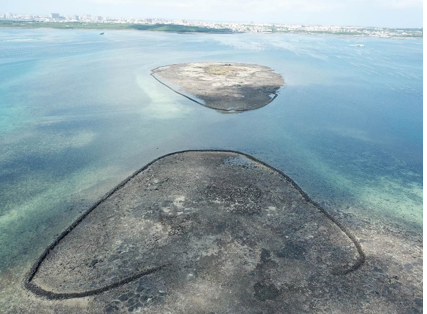
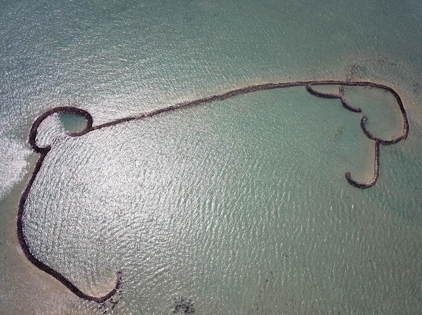
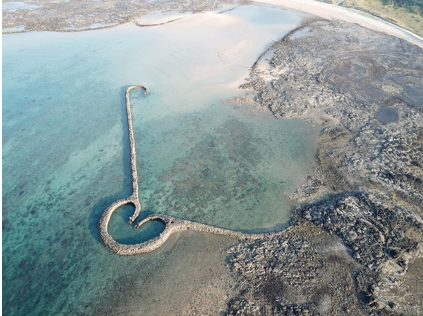
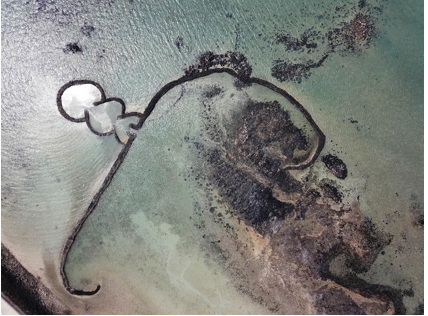
(Source: Stone weir integrated information platform https://stoneweir.info/)

4. Fish caught in stone weirs
In stone weirs, diverse ranges of fish are caught. A fish survey conducted by Hong (1992) revealed that the main types of fish caught include sea lotus whale, small Indian male fish, stinky meat fish, Liwei sandfish, Chinese scorpion, Pakistani bonito, red sweetfish ginseng, and bronze mirror. In addition to these, other types of fish caught in Stone weir include fish ginseng, stinky belly fish, squid, Bandu salmon, Layang fish ginseng, three-line chicken fish, squid chicken fish, four-line chicken fish, flat crane fish, grouper fish, Aonai drill mouth, double-banded bird tail Winter, large scale genus, white hairtail, Liuban puffer, South Sea silver handfish, eel catfish, green-billed dragon, fan squid, as well as crustaceans such as squid, tortoise grouper, damselfish, stingray, and shark.
5. The intertidal zone is rich in snails and shellfish that can be collected by residents
Taking the Chingluo Wetland as an example, there are 15 families and 25 species of snails with economic value, including eared horse mussel (Modiolus auriculatus), variegate venus (Ruditapes variegate), lettered carpet clam (Tapes platyptycha), yellow pitarina (Pitarina sulfurum Pilsbry), tumid venus (Gafrarium tumidum Roeding), true limpet (Lottia luchuana), crowned turban shell (Lunella coronate), Japanese chitons (Liolophura japonica), miniature turban (Turbo stenogyrus Fischer), maxima clam (Tridacna maxima), horn snail (Batillaria zonalis), blotched nerite (Nerita albicilla Linnaeus), Clypeomorus humilis, toothed top shell (Monodonta labio subsp. Labio), leafy ark shell (Barbatia foliate), Zeuxis exilis, script venus (Circe scripta subsp. Scripta), bivalves (Pinna muricata Linnaeus), trapezium horse conch (Pleuroploca trapezium subsp. paeteli), pyramid top shell (Tectus pyramis), Chinese venus (Cyclina sinensis).
The snails and clams in the Qingluo wetlands include a total of 21 species from 13 families that have economic value. They are important food for the residents and also a source of income. People will go to the intertidal zone to collect shellfish, and in the winter, an average villager will spend 2.5 hours collecting mainly razor clams and can pick up about 840 grams. In the summer, they mainly collect thick-shelled latticed venus clams. The shellfish will become noticeably thin, and their activity will decrease, making it difficult to collect them, which reduces the residents’ willingness to collect them.
6.Traditional agricultural architecture and crop cultivation
The progress of agriculture in the fishing village relies on the presence of Penghu Gardens (菜宅 Pinyin: cài zhái). These gardens are constructed with methods that vary based on the geography and terrain of the area. Typically, to withstand the northeast monsoon, the vegetable houses are stacked higher on the north side. The results in a stacking height ranging from approximately 1.8 to 2.5 meters. In autumn and winter, due to lower temperatures and less insect damage, vegetables can be grown in Penghu, including cabbage, Chinese cabbage, winter melon, pumpkin, lettuce, radish, and tomato. However, in areas affected by the northeast monsoon, only peanuts and sweet potatoes are suitable for planting. In summer, due to high temperatures and more insect damage, it is suitable for planting cantaloupes.
Rationale
1. Lack of human resources: Aging population and declining birth rate
The study area is located in Huxi Township. The total population in 2011 and 2021 is 13,699 and 15,447, respectively, of which the number of people aged 0-19 decreased by 474, the number of people aged 60-99 increased by 975, and the number of people aged 20-59 increased by 1,245 (Huxi Township Household Registration Office, Penghu County, 2022). The rise in the number of individuals aged 20-59 can be largely attributed to the migration of both students and professors from Penghu University of Science and Technology. Nevertheless, the aging population and diminishing birth rates remain observable in the fishing villages. Consequently, in the study area, it is imperative to revitalize the fishing township industry and enhance the living conditions to enable young and middle-aged people to reside in the township, care for the elderly, bear children, and sustain the fishing township industry’s growth.
2. The decline of fishery industry and the living quality in traditional villages
Nanliao, Hudong, Huxi, and Hongluo are historic fishing villages located in Penghu. These settlements still embody the traits of traditional fishing village communities in Penghu, including coral stone houses, water wells, Penghu gardens, and ancestral shrines. Nonetheless, these settlements also require assistance in addressing the problems of young individuals migrating for work, the elderly remaining in the settlements, and the decrease in birth rates leading to a dearth of human resources. These issues have resulted in a continuing decline of the living space and environment, limited industrial development, cultural heritage inadequacies, and the traditional fishing grounds (stone weirs) needing to sustain themselves. However, given that Penghu is an island that focuses on island culture, marine ecology, and intertidal tourism, it has become crucial to revive the environment and culture of the fishing villages while accounting for the island’s distinctive traits.
3. Loss of function and challenges of restoration for traditional fishing grounds, stone weirs
3.1 Decrease in fish population
In 1952, the Penghu County Government utilized a “revolving fund” to construct motor-powered fishing crafts and loan them to fishermen. Subsequently, in 1957, motor-powered fishing boats were opened to release collars, hastening the fishing industry’s progress. By 1964, the count of Penghu fishermen had surged to over 60,000. However, with Taiwan’s industrial structure transitioning, a processing export zone was established, absorbing the workforce of Penghu’s outlying islands. The fishery resources, dependent on fishing, were gradually depleted, resulting in Penghu’s fishery industry experiencing a continuous decline (Li, 2008). The depletion of marine resources in Penghu is primarily attributed to two factors. Firstly, the fast-growing demand for seafood products in Taiwan and mainland China has resulted in unrestricted large-scale fishing, jeopardizing the survivals of coastal female fish, sea cucumber, and sea urchin. Secondly, the ease of goods delivery facilitated by logistics and transportation has driven consumer demand, leading to a significant surge in fishing activities by operators and contributing to the decline in fish populations.
3.2 Dying coral reefs, leading sedimentation of stone weirs
The decline of fishery in stone weirs can be attributed to several factors. These include typhoons and climate change, which have caused a rise in sea temperature and environmental pollution. These factors have resulted in the death of coral reefs and accumulated coral reef debris in stone weirs, reducing their capacity to serve as a wildlife habitat. As a result, there has been a reduction in the number of fish that can thrive in these areas.
3.3 Lack of maintenance and management for stone weirs
The fishing rights in stone weirs were divided and passed down generations to generations in equal shares, leading to confusion about rights and responsibilities and a lack of transparent management. During its peak, there were up to 609 counts, but a subsequent survey conducted by Li (2008) in 2011-2012 revealed that only 114 (18.7%) of these stone weirs in Penghu were usable.
3.4 Difficult to restore stone weirs
The restoration of stone weirs is challenging due to five primary aspects, which are detailed below:
(A) Economics aspect: The process of building a stone weir, from transporting the necessary materials to completing the structure, typically takes seven to ten years. To complete the project, constructing a stone weir requires the collective efforts of multiple local families. However, since stone weirs are no longer adequate for catching fish and have lost their economic value, their owners are often unwilling to invest significant amounts of time, labor, or money in repairing them.
(B) Property right aspect: Building a stone weir is a demanding and time-consuming task that typically requires the collective efforts of many individuals. It can take several years to complete and often involves the participation of entire families, villages, and even multiple clans. Participation in the construction and restoration process confers the right to use the stone weir once it is complete. Those who do not participate in the early stages of construction will not be able to participate in the restoration efforts, which can limit the restoration speed.
(C) Technical skill aspect: In the past, the low literacy rate and a general lack of awareness regarding text and video records led to incomplete documentation of stone weirs’ construction and restoration techniques. Furthermore, restoration technology following the collapse of stone weirs is less advanced than earlier. Given the need for more labors to carry out rapid and large-scale restoration efforts, the speed of the stone lake collapse has outpaced the pace of restoration work. Consequently, the number of intact stone lakes continues to decline.
(D) Limited sources of raw materials: The potential for restoring collapsed stone weirs depends on the condition of the underlying foundation stones. In cases where the foundation stones have become buried due to silt accumulation, restoration is still possible if the approximate location of the original stone weir can be identified. In addition, it is necessary to evaluate the availability of local stone materials. If the original stone materials have not been lost due to factors such as excessive mining or significant environmental changes, there will usually be enough nearby stone materials to support the restoration effort at the exact location.
(E) Tidal restrictions: The construction of stone weirs is significantly impacted by tidal patterns, which are among the most critical factors to consider. In Penghu, the wind and waves are typically mild, only from June to September each year. As a result, the window for sea activities is limited to approximately three to five days before and after high tide and lasts up to two weeks per month. Workers can only remain in the stone weir restoration site for a few hours daily. This restricted schedule makes the process of repairing a stone lake quite time-consuming.
The preceding exposition underscores the significant role played by stone weirs in the traditional fishing practices of Penghu’s fishermen. However, the upkeep of these structures has become increasingly challenging due to various factors, including economic constraints, property rights, technological limitations, material shortages, and tidal effects. Consequently, the percentage of operational stone weirs has dwindled to a mere 18.7% of the total existing structures. Given the difficulty of promptly repairing damaged stone weirs, it is imperative to explore alternative uses for the intertidal zone and contemplate possible modifications to address this issue.
Activities and/or practices employed
1. Cross-sectoral partnerships of stone weir preservation and revitalization
The partnerships for the preservation and revitalization of stone weirs mainly include the Penghu National Scenic Area Management Office, the Penghu County Government, the National Penghu University of Science and Technology, the National Science Council, Water and Soil Conservation Bureau, and the Ministry of Culture. Professor Mingru Li of the National Penghu University of Science and Technology played a crucial role in conducting systematic and complete investigations of stone weirs, building a database, and cooperating with the National Science Council for digital filing. On this basis, cooperate with the Penghu National Scenic Area Management Office and the Penghu County Government to promote a series of Stone weir experience activities, such as “2005 Penghu County Cultural Festival”, “The Fifth Academic Symposium on Penghu Research – Stone weir Fishing “Singing”, “2006 Jibei Stone weir Cultural Experience Camp in Penghu County”, “2007 Penghu County Season”, “2008 Sea Fields in the Waves – Wisdom of the Ancestors in Stone weir”, etc., gradually made issues related to Stone weir more popular in China.
The Ministry of Culture actively subsidizes the repair and technique inheritance of stone weirs in the Jibei area to promote research on the topic. In 2007, according to the Cultural Heritage Preservation Act, the Penghu County government registered the Shuangxin Stone Weir in Qimei as a county-level cultural landscape. In 2008, the Jibei Stone Weir group was also registered as a cultural landscape. In 2009, the Council for Cultural Affairs listed the Penghu Stone Weir Group as one of the 17 potential world heritage sites in Taiwan. The Penghu County Cultural Affairs Bureau published a book entitled “Penghu’s Stone Weirs” in 1999 and a book on stone weirs entitled “The Origin and Distribution of Fishing Weir Culture: An Exploration from an International Perspective” in 2009. Since 2017, the Soil and Water Conservation Bureau has been involving university students and young people in the investigation and reutilization of stone weirs, including stone weir investigations, the construction of a stone weir-themed website, the training of young stone weir artisans, stone weir ecological experiences, and marine education related to stone weirs. In addition, the “Salute to the Sea” policy promoted by the Ocean Affairs Council encourages Taiwanese people to understand, appreciate, enter, and preserve the ocean. Stone weirs are an important site for Taiwanese people to understand the importance of intertidal zones in the ocean.
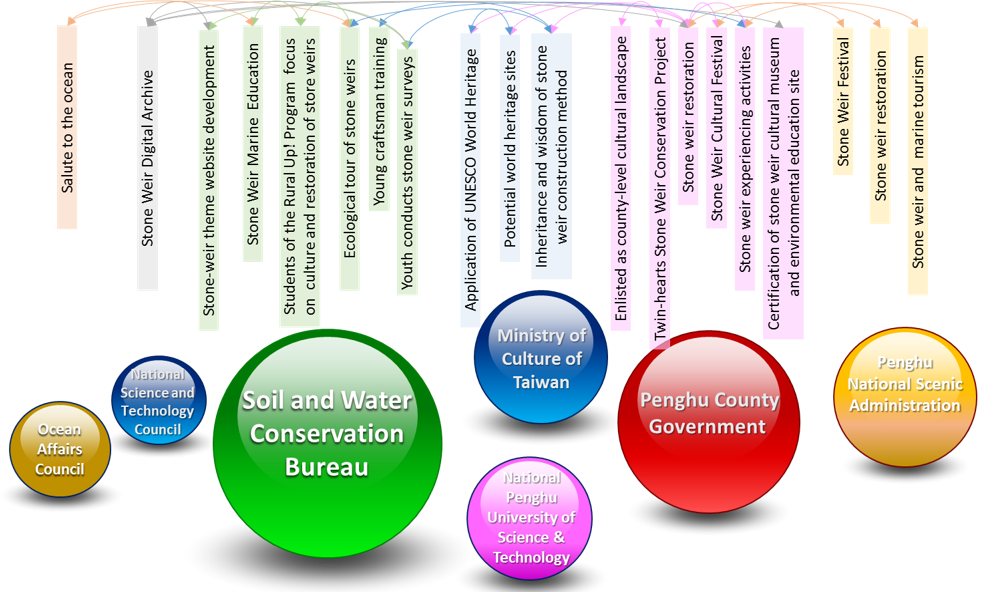
2. Protection of Taiwan’s Wetlands of Importance in the intertidal zone
Hongluo Village is situated within the expansive Qingluo Wetland, which is the largest area of mangrove restoration in Penghu. This wetland serves as a vital habitat and wintering location for numerous migratory birds, with thousands passing through or wintering there annually. The area boasts a wealth of natural and human ecological resources, including Hongluo Bay, which is a significant breeding ground for juveniles, and the intertidal zone, which is abundant in fishery resources.
On January 28, 2014, the Penghu County Government declared an area of approximately 250 hectares in Hongluo Village as No. 1040800278 under the “Wetland Conservation Law”, designating it as an essential wetland of national significance. The Conservation and Utilization Plan of Qingluo Wetland aims to preserve the wetland’s ecological integrity and stability, foster sustainable development of the surrounding environment, and bolster conservation and restoration efforts. The management of the wetland’s natural resources and ecological functions adheres to the principles of conservation and wise use, which include:
(A) Priority should be given to the protection of natural wetlands and the maintenance of their water resource systems.
(B) The conservation of animal and plant resources in wetlands should be strengthened.
(C) Adequate planning and maintenance should be conducted for wetlands with ecological network significance, as well as the surrounding environment and landscape of the wetland.
(D) Efforts to enhance the wetland system should encompass a holistic approach that integrates wetland restoration, flood control and detention, water purification, water resource conservation and utilization, landscape, and recreation into the overall planning process. As appropriate, constructed wetlands may be strategically located and designed to support these objectives.
3. Implementation of rural revitalization
3.1 Revitalizing fishing villages by attracting youth and investing in ecological conservation, education, and experience-based economy
The Soil and Water Conservation Bureau (SWCB) is primarily tasked with promoting the rejuvenation and revitalization of agricultural and fishing villages, thereby enhancing their self-sufficiency and attracting youth to stay or return to rural communities. The bureau aims to encourage the participation of young people from different fields in regenerating these villages while facing challenges such as a lack of independent creation concepts, inadequate capacity, and insufficient human resources. Addressing these challenges requires a focus on the educational level and providing opportunities for youth to participate in the development of these villages. To this end, the bureau has established several programs, such as the “Farm Stay of College Students”, “Rural Up! Competition”, and “Rural Up! Plus Action Plan”, which enable students from non-agricultural fields to partake in rural development. These initiatives leverage students’ creativity and diverse expertise to support the promotion of redevelopment-related work in agricultural and fishing rural communities. In Penghu, notable initiatives include the rural migration competition for college students and the innovative research and demonstration plan for youth returning to rural areas.
(A) Rural up! Competition: This project invites teams comprised of 6-10 members and a primary instructor from both public and private colleges and universities across the country, including university departments and research institutes, to participate. Cross-school teams are also encouraged to engage. The resident team is given the opportunity to interact with the community after school and during summer vacation to gain insights into farming (fishing) villages, farmers (fishing) people, and agriculture. Through this initiative, young people can apply their innovative thinking and professional knowledge towards developing farming (fishing) village communities. Between 2015 and 2019, nine student teams comprising approximately 60 individuals from the Penghu area participated in this program.
(B) Innovative Research and Demonstration Project for Youth Returning to the Countryside: The subsidy program comprises two categories of recipients. The first category includes individuals, specifically young people under the age of 45, or a team of young representatives, who are encouraged to develop innovative research proposals to address issues within agricultural and fishery villages or industries. The second category is the co-creation group, which involves collaboration between farmers’ associations, legitimate foundations, and groups from different domains to invest in agricultural or fishery villages and improve various aspects such as production, technology, construction methods, education, services, marketing, and technology. Between 2018 and 2023, the Bureau of Soil and Water Conservation supported six young individuals in promoting innovative research projects in the research area. These projects include the “Seeking Sea People Looking for the Pool Zhi Project” promoted by Yang (2021), the “Flower House Gathering Trendy Shoes Craft Culture Innovation Project”, “Penghu Fish Eating Base-Eating Fish to Close the Distance between People and the Sea” promoted by Wu Jiarong, “Renaissance and Space Reconstruction of Fish Stove Industry” promoted by Zeng Youji, and the “Salted Fish Turnaround – Penghu Seafood Value-added Plan”, among others.
3.2 Improvement of rural living, production, ecological, and cultural environment, and enhancement of quality of life
The Rural Revitalization Act was passed in 2000 to promote sustainable development in farming and fishing villages and revitalize rural areas. The act designated the Soil and Water Conservation Bureau as the central administrative unit responsible for this task. The key objectives of the act included improving primary production conditions, preserving rural ecology and culture, enhancing the quality of life, and creating a prosperous new countryside. As of December 2022, 64.15% of the 4,232 rural communities in the country (2,715) have participated in the Grass-root Cultivation Project for rural residents. Additionally, 1,000 communities (23.63%) have submitted community development plans after receiving personnel training. These plans will focus on community environmental improvement, industrial activation, cultural preservation, and ecological conservation, in line with the local planning and development. Here are the summarized accomplishments in the study area promoted by the Bureau of Soil and Water Conservation over the years:
(A) Improvement of the rural production environment and living space: The community plays a critical role in improving the overall primary environment of farming (fishing) villages, which includes improving community roads, drainage ditches, recreational spaces, enhancing living functions, maintaining existing facilities, and other amenities, all aimed at creating a habitable rural environment. In the period between 2015 and 2018, the Nanliao community implemented four settlement environment improvement projects. In addition, between 2016 and 2021, the Hudong community undertook three settlement environment improvement projects, as well as farm pond ecological environment construction projects, all aimed at improving the quality of living environments and restoring ecological habitats in fishing villages through these initiatives.
(B) Creating highlights of rural and regional development: The Tainan Branch of the Soil and Water Conservation Bureau is an organization that spearheads multi-disciplinary cooperation to promote various aspects such as environmental improvement, agricultural production technology, industrial planning and design, industrial promotion, marketing, environmental conditions, cultural preservation and utilization, and ecological conservation. In collaboration with the Nanliao Community from 2012 to 2021, the Tainan Branch of the Soil and Water Conservation Bureau promoted various initiatives such as community resource investigation, revitalization of idle houses, environmental greening and landscaping, cultural resource investigation, and video recording. The goal was to position Nanliao Community as a green tourism destination for historic fishing villages. Meanwhile, the Hudong community focused on initiatives such as greening and cleaning dirty places, improving traditional domestic water spaces, setting up field windbreak facilities, research and development of cabbage acid and peanut processing products, and ecological experience activities in the intertidal zone. These efforts aimed to enhance industries, improve the quality of living environments, and develop eco-tourism. The Hongluo community focused on restoring traditional fish stove culture and creating experience spaces. The Huxi community’s primary focus was to improve the overall comfort of the community by enhancing the living environment.
(C) Promoting the development of value-added experience in rural communities: Efforts have been made to enhance the quality of service provided for rural experience tours. Since 2020, concerted efforts have been made to assist rural communities in improving essential service quality for rural experiences. A sustainable, diversified, and hospitable rural experience service and environment have been established as part of this endeavor. Additionally, high-quality rural experience evaluations have been handled, with 62 high-quality unit operators passing the evaluation. As a result, 62 selected experience itineraries have been launched, including promoting light travel in Nanliao life in the Nanliao community and the stone weir restoration and ecological experience tours in the Hongluo community. These initiatives have contributed to the growth of the experience economy in Yucun.
Results
1. Utilizing primary data to enhance stone weir protection and transformation on a theme website
1.1 Stone weir survey, basic data construction
Professor Ming-Ru Li was granted funding by the Ministry of Science and Technology between 2005 and 2007 to digitize authorized documents for collection, conduct field investigations at various stone weir sites, and capture photos of each site. The resulting database contains information on 592 shoals, including photos, satellite positioning, shovel measurement data, shovel type and evolution, shovel structure, related fishing methods, and fishing gear and equipment. Additionally, the team developed shovel 2D engineering drawings, Yuyou Stone weir 3D animation, Baisha Township flight simulation systems, and other video information, as well as a research framework model to guide and search data, with seven principal axes: proper nouns, architectural forms, industry, humanities, bird’s-eye view of stone weirs, belief legend, and stone weir documents. The team carried out systematic digital filing work to enhance the accessibility and usability of the data.
Fu-Ci Yang’s (2021) research project received funding from the Soil and Water Conservation Bureau’s Innovative Research and Demonstration Project for Youth Returning to the Countryside. The study involved designing 39 flight routes for capturing aerial photographs of Penghu fishing villages and identifying the location of 609 stone weirs through aerial photography. The analysis of the aerial photographs revealed an increase in the number of stone weirs, new stone weir forms, and unique stone weir structures. To date, 112 stone weirs have been completed, with an additional 338 new ones recorded in 2021. In addition to the fieldwork, an integrated information platform was established for stone weirs, containing knowledge on stone weir terminology, structure, construction method, and development. The project also included the continuation of data and field investigations initiated by Professor Ming-Ru Li of Penghu University of Science and Technology. The resulting database was used to create a complete, multi-functional information platform for stone weirs. This platform includes information on stone weir construction methods, stone weir files, traditional craftsman lists, young master training, ocean education, and eco-tourism, aiming to address the gaps in previous field investigations and expand the power of integration.


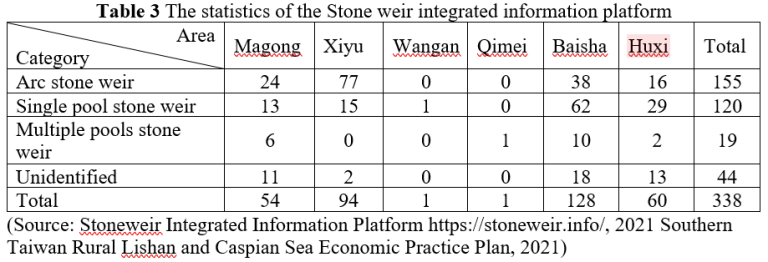
1.2 Theme website development
The study area under consideration primarily encompasses the Hongluo community, where the majority of stone weirs are located. As per the “Stone Weir Integrated Information Platform” records, a total of six stone weirs can be found in the Hongluo community, namely Donghu, Xihu, Dahu, Dahu, Inner Port, and Outer Hu, with Dahu being the largest stone weir in Penghu. Notably, Dahu, Inner Port, and Outer Port are situated in the Qingluo National Important Wetland, thereby highlighting their ecological significance.
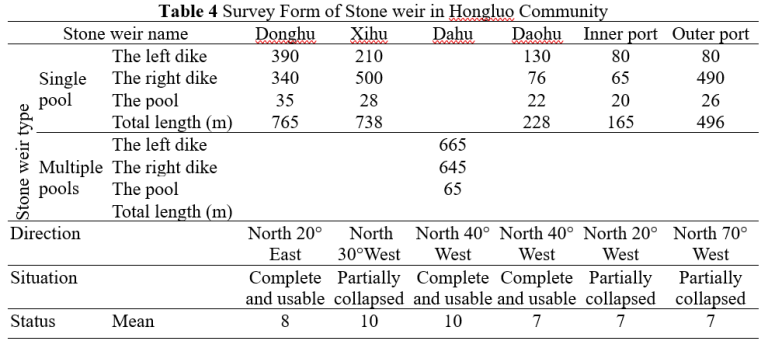
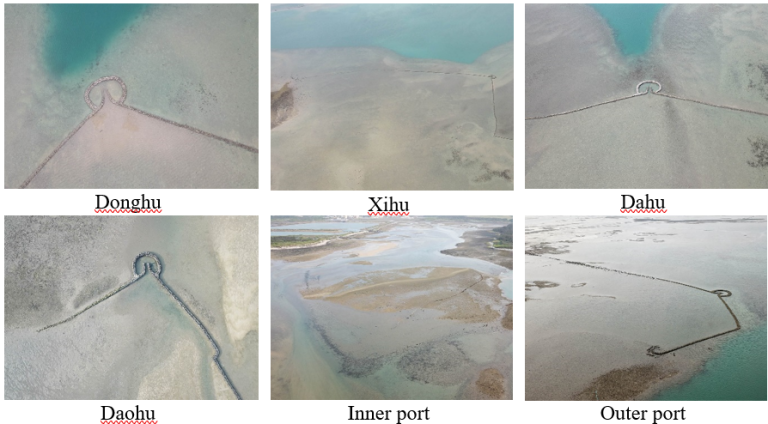
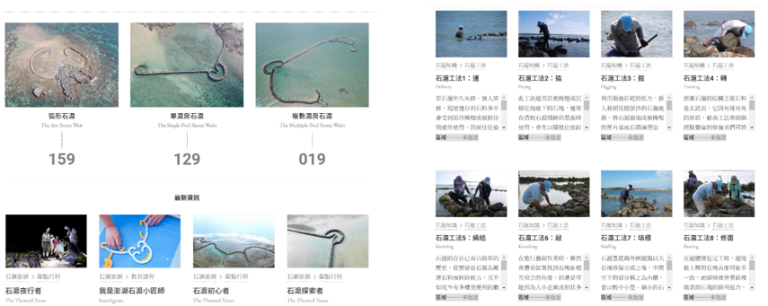
2. Transformation of stone weir functions
2.1 Promoting emotional connection and mutual trust among neighbors through collaborative efforts in building stone weirs
Historically, the large size of stone weirs made it difficult for individuals to construct them alone. As a result, joint ventures were formed based on blood or geographical relationships, and individuals collectively invested in constructing the stone weirs. These joint ventures were then passed down from generation to generation, and the local people recognized the ownership of these stone weirs as “common private property”. Each village had specific and appropriate regulations for constructing stone weirs, managing the building pools, distributing fishing rights for patrolling pools, and dividing catches (Hong, 1999). In Penghu County, there are four forms of ownership for stone weirs: shared ownership by small geographical groups within the community, community temple co-ownership, ownership by small clan groups within the community, and individual family ownership (Li, 2008). Descendants of those who jointly built the stone weirs can still take turns patrolling and fishing in the stone weirs, based on the inheritance agreement of past generations – the field of catch sharing. The construction and management mechanisms of stone weirs have become an intriguing research topic in the study of fishing village operation systems.
2.2 Implementation of ecological engineering methods for the establishment of intertidal biological habitats and protection of ecosystem services
The stone embankment is a commonly used ecological engineering method in the intertidal zone. When constructing the barrier, certain factors must be taken into consideration. Firstly, suitable stone materials are essential. Basalt or boulders are primarily used as the primary stone material for the outer layer of the barrier, while coral reef limestone is the preferred material for the inside of the barrier. Secondly, the tidal range is also an important consideration. A more extensive tidal range is preferable, as it enables fish to be brought into the pool during high tide and trapped within the pool as the tide recedes. In order to resist the changes in wind, waves, and tides, stone weirs are often constructed in arc-shaped walls, which can be over 1.5 meters or even 2 meters high, with the ends bent into a spiral shape. Fish-collecting houses or even two fish houses may be added for more complex structures. Structures such as entry opening, left dike, right disk, fish pool, and narrow areas have also been developed to meet specific fishing needs (Hong, 1999).
Currently, the stone masonry method used in the construction of stone weirs is a vital craft and a significant intangible cultural asset. This method involves various techniques, including how to transport heavy stones to the location of the stone weir, how to move stones through cooperation using knots, how to use the principle of leverage to loosen the bottom rock through prying, how to flip the base stone using the grip of the two-tooth nail rake through digging, and how to put the stone at the most suitable angle through turning. The method also includes techniques for punching out more prominent stones to enable them to be inlaid tightly, making the surface smooth. Additionally, relatively small, medium, and small stones are used to “fill the cabinet” between the base of the stone and the outer wall, as well as on the body. When the project is nearing completion, the height of the stones on the uppermost layer is adjusted and arranged so that they are as flat as possible to facilitate the patrolmen’s walking on the stone (Yang, 2021).
The intertidal area near the Hongluo Community includes three stone weirs (inverted lake, inner port, and external port) and vast shoals that have become important national wetlands. Investigating resources and fish caught in this area has identified 59 families and 159 species. The dominant families include 10 species of Gobiidae (accounting for 6.3%), 8 species each of Trevalidae and Snapperidae (each accounting for 5.0%), 7 species each of Scorpionidae (accounting for 4.4%), and 6 species of Anchoridae each (each accounting for 3.8%), 5 species each of Herringidae, Flounderidae, and Tetradental Fuguidae (each accounting for 3.1%).
The dominant fish species caught in the Hongluo bay area are Japanese water skies, black-tailed small sardines, short-nose stalked dogfish, mullet, and Aonei drill mouth, which account for 72.8% of the total number of fish caught. The life history stages of fish in the area are mainly juveniles, and the functional groups suggest that the habitat environment used by fish is primarily nurturing. This nurturing environment is also an indicator species in Qingluo Wetland. The area is an important breeding and habitat for the Chinese horseshoe crab, highlighting the crucial role that Stone weirs and wetlands play in providing critical habitat ecological service functions.
2.3 Shifting the focus of stone weirs from fishing to diversified ecological and cultural development amid declining fishing functions
The stone weirs’ fishing function has seen a decline due to several factors, such as decreasing fish populations, siltation of stone lakes, coral reef degradation, and insufficient maintenance and management. Nonetheless, various organizations, including the Penghu National Scenic Area Management Office and Penghu County Government, have recognized and promoted the multi-dimensional values of Stone weirs. Efforts to encourage ecological conservation, environmental education, and ecological experiences in Stone weirs and fishing villages have been underway. Revitalization plans have been implemented to encourage young people to return to their hometowns, promoting fish-eating culture, education, and tourism while preserving the Stone weir and wetland ecology. For example, the Hudong community focuses on freshwater wetland restoration and intertidal ecotourism, the Hongluo community on Stone weir and wetland ecology preservation, and the Nanliao community on cultural preservation and green tourism.

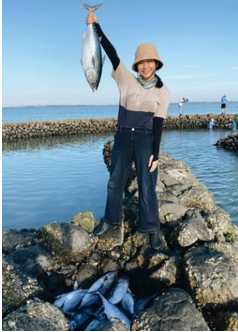
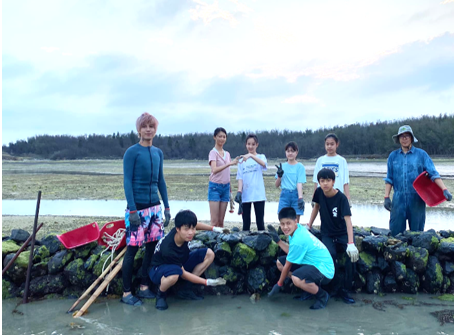
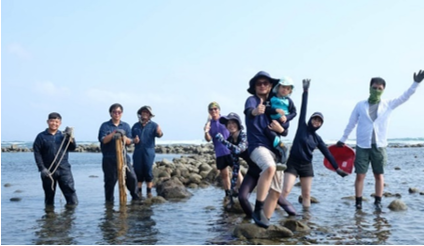

3. Establishing a youth cooperation platform to jointly promote ecological conservation, education, and experience economy in stone weirs and fishing villages
3.1 Establishment of the Penghu agro-island-ocean youth revitalization association by young peasants
In 2022, the Penghu Agro-Island-Ocean Youth Revitalization Association was established in collaboration with the Tainan Branch of the Bureau of Soil and Water Conservation, the Bureau of Agriculture and Fisheries of the Penghu County Government, and the Bureau of Culture. They created the “Penghu Partnership Collaborative Creation Experimental Base” with a focus on promoting youth cross-domain co-creation. The target audience is young adults over 20 years old in the hotel industry who are registered or living in the farming and fishing villages of Penghu County. The goal is aligned with four corresponding objectives:
(A) To carry out the Penghu County youth guidance on exchange planning and operation management,
(B) To encourage the creation and development of youth industries in Penghu County, education and exchange platforms, cross-border cooperation, and support for innovation and entrepreneurship,
(C) To promote the development of youth entrepreneurship in Penghu and promote social welfare,
(D) To foster youth entrepreneurship and strengthen the integration of education and society.
It presents an opportunity to work together to put into practice the “ecological construction of agricultural and fishing villages”, “preservation of traditional culture and skills of agricultural and fishing villages”, “creation of friendly and characteristic agricultural and fishing village space”, “promotion of food and agriculture (fish) education”, and other initiatives in Penghu County. The cross-sectoral collaboration will generate benefits and enable us to identify appropriate business models. With the community’s efforts, we will promote a sustainable tourism experience in agricultural and fishing villages and support the youth of Penghu County by integrating business benefits, tourism education, and the sustainable management of the ocean.
There are 50 members in the association, more than 80% of whom are young people under the age of 45. There are more than 15 businesses founded by young people, including “Of course we sell our fish”, “Seabirds love to eat”, “Penghu You Fresh”, “Stealing melons and jujubes”, “Fishermen”, “O2 sea waste laboratory”, “A corner of Judao”, “Li-Seaglass”, “Every year there are fish”, “Island weaving has tides” , “Happy Mountain and Sea Food”, “Grass Root Fruit”, “Xuxi Bakery”, “Happy Mountain and Sea Food”, “Xiaodaojia” and so on. It shows that the Penghu Agro-Island-Ocean Youth Revitalization Association has exerted the power of mentoring young people to set up businesses independently; it can integrate the ability of young people to form alliances with different industries and mutually drive sales to increase. Let young people who return or stay in Penghu settle down, work in peace, and continue to promote work that contributes to environmental protection and local industry development.
3.2 Promoting Ecological Conservation, Education, and Experience Economy by Youth Advocates
(A) Fostering ecological and environmental education through the restoration of stone weirs: With the restoration of stone weirs, Fu-Ci Yang organized a workshop on stone weir repair and collaborated with craftsmen, stone weir owners, and other relevant stakeholders, with the assistance of the 2016 “College Student Migration Project” and the 2017 “Youth Returning Project” of the SWCB, to discuss appropriate restoration points. The plan involved recruiting 17 people, including 5 locally trained young artisans, under the guidance of the craftsmen, to restore two stone weirs within four weeks, achieving restoration levels of 60% and 80%, respectively. Additionally, they partnered with residents to organize activities such as guided tours, working holiday and events on repairing stone weirs. As a result of the restoration efforts, various species, such as red Hukui clams, cuttlefish, horseshoe crabs, lionfish, and other creatures, entered the pool one after another, indicating a restoration of biodiversity.
The restoration of stone weirs has not only preserved cultural heritage but also recorded restoration methods and practices for future generations. Furthermore, it holds significant educational and advocacy values. They aim to establish a new education model through collaboration with local schools, workshops, non-profit organizations, and other entities. Together with young people, Integrate Service Co., Ltd. is handling Stone weir environmental education courses for elementary and junior high schools and tourists. Through these efforts, they have verified that stone weirs are an essential ecological education field that showcases the unique features of Penghu’s intertidal zone.
Due to the constraints of tidal time and safety concerns, accessing a stone weir can be difficult for students in primary and secondary schools. Renting equipment, scheduling class time, and bearing outdoor risks can pose challenges. However, with the assistance of stone weir board games, the general public, including kindergarten students, can learn about stone weirs in ease and an interactive indoor setting. In addition, primary and secondary schools in Penghu have taken active steps to develop unique courses. However, due to a shortage of teachers in Penghu, instructors may need channels or non-undergraduate majors to facilitate relevant courses. Relevant educational organizations are eager to integrate the stone weir culture into curriculum contents of local schools and raise awareness regarding marine ecosystems among children from an early age.
Moreover, three stone weir-themed touring itineraries have been launched to “lure” participants diving into the culture of the stone weir and the intertidal zone. These itineraries allow participants to experience and operate traditional fishing methods, engage in fish stove cooking and extend the intertidal fishing methods experience to conventional food. Participants gain in-depth experiences in the traditional life of Penghu’s fishing villages.
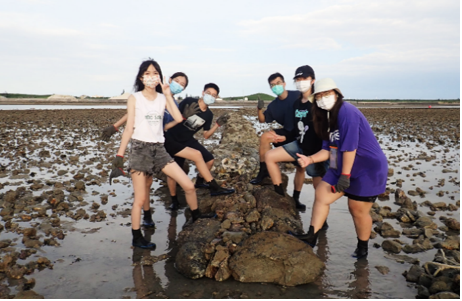
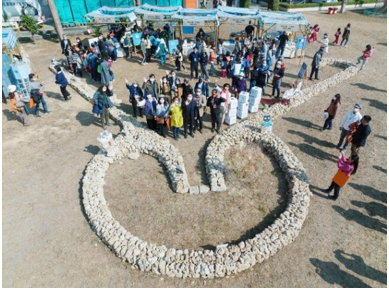
(B) Utilizing local culinary wisdom to promote fish-eating education: There is a widening generational gap among the locals in Penghu, resulting in a gradual loss of fish-eating culture and local skills. Furthermore, tourists to Penghu lack proper knowledge and need to be education in how to consume fish wisely. Miss Wu is actively promoting fish-eating education to raise awareness of the journey of “fish” from the sea to the dining table. Through the act of “eating fish”, Wu aims to bring people closer to the sea by teaching them about the fishing process, the techniques used, the stories of fishermen, and the culture of Penghu.To promote this initiative, Wu has established a bookstore to promote fish-eating culture and knowledge, created a hands-on seafood classroom to increase the concept of sustainable seafood, invited community elders such as Chef Qingyin to share meals, organized fish market tours and fish cooking observations, and diversified enjoyable fish-eating activities. These efforts aim to bridge the gap in fish-eating culture knowledge between locals and tourists, and to ensure that the culture and skills related to fish consumption in Penghu are preserved for future generations. On the other hand, it encourages consumers to choose ocean-friendly seafood to sustain marine fishery resources. The promotion method is to reuse the trash fish to build the Penghu seafood brand to increase the operating income of the business model.
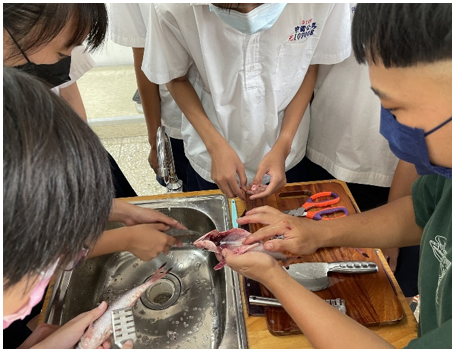
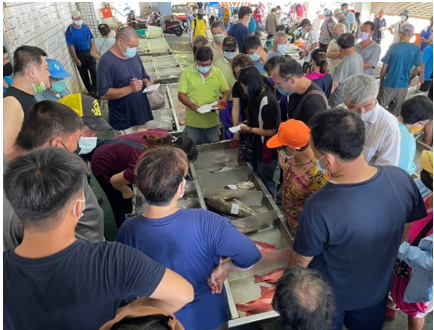
(C) Inheritance and innovation of plant weaving culture: The Island Weaving Team is dedicated to preserving cultural memory, revitalizing traditional techniques, and promoting innovation. They strive to create opportunities for local development by utilizing natural materials found in Penghu, practicing the spirit of “taking from nature and using them in daily life”, and promoting the weaving culture of the Penghu Islands.
The main handicrafts are:
- The weaving creation of white thatch grass.
- The cultivation of traditional straw sandal skills.
- The development of weaving products from discarded fishing nets.
The Island Weaving Team plans to revitalize idle spaces, such as flower and vegetable houses, to create value from plants and marine waste. They also aim to document traditional weaving methods, improve tool design, and cultivate local skills. In partnership with Wang’an Elementary School and other schools, six local youths and residents will participate in art and literature intensive cultivation courses and natural collection and application workshops with cultural creators and local cultural and historical workers. Additionally, the team will promote its craft by connecting with other industries and expanding outwardly. It will involve organizing cultural craft experience activities with communities and educational groups and placing cultural and creative products on the shelves of cultural and creative stores. By adopting a cross-industry approach, the team hopes to expand the reach of its cultural and creative products’ reach and promote the Penghu Islands weaving culture.
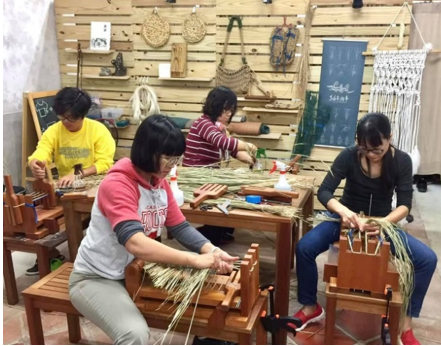
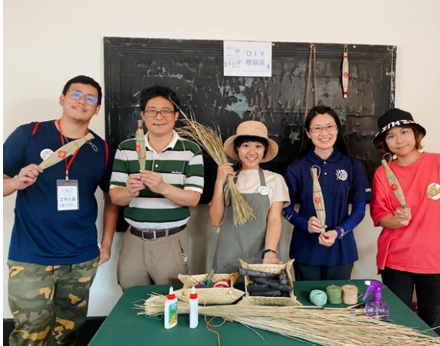
(D) Promoting the traceless service platform to mitigate environmental impacts on the ocean: Tourists and locals alike can deepen their experience in Penghu through an exclusive Penghu-style brand that matches local communities, youths, groups, and other commodity gatherings. This initiative will establish a physical exhibition and sales space and an online integration platform to promote consumption and support local businesses. This win-win situation aims to bring the best of Penghu to the world and encourage sustainable living. The ocean and agricultural land are sources of nutrients for the residents of Penghu. Therefore, sharing the benefits of farming, fishing, and land is essential while promoting sustainability and traceless intention in daily life. Developing the “Sunny Penghu Addicted Penghu” brand and establishing a positive cooperation model can help partners in farming and fishing villages grow and develop together. This approach ensures they no longer have to work alone but can share their resources and knowledge to pursue a more sustainable future for Penghu.
The first step is to take inventory and match agricultural and fishery products, handicrafts, creative life, and other commodities, including vegetables and foods grown in a friendly environment, unique processed agricultural and fishery products, handmade baked snacks, cultural and creative products, and limited seasonal items. The initiative will provide counseling and optimization for the production end of existing products, identify potential brands, and assist in developing exceptional products. This approach will enable producers to stabilize the quality and output of their products for sale on the shelves, ensuring a reliable and consistent supply for consumers.
The following action to promote the cultural richness of Penghu is to encourage collaborative storytelling and recording of the local communities and commodities. Inviting people familiar with Penghu’s landscape to write and record their experiences and observations about the local communities and products can be a practical approach. Through visuals such as pictures, texts, and even videos, the general public can gain insight into the local conditions and customs of the place of production. It can help bridge the gap between people and the locale by allowing the viewers to witness and appreciate the origin’s customs and practices, fostering a closer relationship and a deeper understanding of the place.
The third initiative aims to reduce environmental impacts caused by solid waste on Penghu Island by designing customized services for tours, meal parties, and meal boxes free from any traces of origin. It also involves promoting event supplies and tableware rental services in Penghu, including catering for public department seminars or meals for various activities. The initiative aims to minimize the amount of solid waste generated on the island by offering these services.
The fourth initiative focuses on community and youth group theme curation by providing themed curation spaces in physical stores. It invites communities and youth groups to showcase brand stories through exhibitions and present Penghu’s local life, culture, and industrial development characteristics. The exhibitions highlight the soft power of agricultural specialties and cultural and creative industries, offering visitors an immersive experience and a deeper understanding of Penghu.
Furthermore, another initiative is to establish a non-trace physical product selection exhibition and sales space or an online brand integration platform. This initiative adopts the sales model of non-trace naked sales in the physical store. The non-trace packaging is suitable for small purchases and batch orders, reducing leftovers and maintaining the freshness of ingredients. It helps prevent over-consumption and a stockpile of products that expire and eventually get discarded. Additionally, custom-made gift boxes are designed for customers with gift-giving needs, using packaging methods that reduce the environmental burden. This initiative balances packaging creativity and product aesthetics while reducing environmental impacts.
4. Empowering youth to revitalize fishing villages and repurpose marine cultural resources
4.1 Nanliao community: a fishery culture and green tourism destination
The Nanliao community is home to well-preserved traditional fishing village buildings, such as Xu Hui’s ancient house, a Penghu County Government-registered historic building with religious and artistic significance. The Nanliao Ancient House Group comprises 10 traditional buildings made of coral reef stone, still retaining the original features and standard architectural style. The coral reef stone tree house is a unique M-shaped building that serves as a traditional oriental medicine shop for residents. The east room functioned as a residence, and the west room was a barber shop for the community. The village settlement also features water wells, fish stoves, Zhao’s ancient houses, cow dung caves, red soil ditches, and vegetable houses, still arranged along both sides of the main road in a traditional fishing village spatial pattern.
Since 2016, the youth have collaborated with the Nanliao community to implement an application plan, which led to establishing of a small farmers’ market, promoting local agricultural products through local sales and rural community tourism. The initiative was recognized as one of the “Top 100 Green Tourism Destinations in the World” from 2017 to 2018, announced by the Berlin International Travel Exhibition. This accomplishment boosted the self-confidence of community residents and young people, attracting more people to participate in community affairs and volunteer work, such as environmental cleaning, maintenance, and tour guiding. Currently, the community has about 21 volunteers, including regular collaborators aged between 46 and 90 years old, returning youths aged between 25 and 45, and professional and skilled personnel. The number of visitors has increased yearly, with 108,000 in 2016, 110,000 in 2017, and 120,000 in 2018. However, the COVID-19 pandemic in 2020 caused a drop in visitors to 114,000.





(Source: Guibi Hong Kong Society_ Penghu Nanliao Facebook Fan Special)

4.2 Hudong community: freshwater wetland restoration and ecotourism
“Penghu Garden” serves as a distinct agricultural production site in Penghu settlements, where an innovative project called the “vegetable house” literally has been developed to withstand the adverse effects of solid monsoons on crop growth. To construct these houses, local farmers collect coral reef stones from during low tide from the sea, which is used to build protective walls that shield crops from salt rain and wind damage. The walls are strategically designed, with the north wall being the highest, ranging from 1.6 to 2.5 meters, while the east and west walls follow, ranging from 1.5 to 1.8 meters, and the south wall being the lowest, likely no more than 1 meter.
The use of coral stones in the construction of the vegetable house eliminates the need for adhesives such as cement or lime, thereby preserving the natural gaps between the rocks, which promote air circulation inside and outside the house. During the winter, the walls can resist the northeast monsoon, while in the summer; the gaps between the stones provide ventilation, creating a relaxed environment ideal for plant growth. The crops are grown in the vegetable house mainly consist of low vegetables like cabbage, kale, and radishes, and the farmers consider the height of crops when planting. For instance, fruit trees such as papaya and guava or taller crops such as corn are planted beside the highest wall to prevent lower yields due to overshadowing. The cultivation techniques of the “Penghu Garden” also demonstrate the farming wisdom of protecting common crops through high crops. This means that the more one ridge is produced, the lower the yields will be, and hence, it is important to consider planting taller crops beside the high walls of the vegetable house to promote overall crop growth.
Using the Penghu Garden in Penghu has allowed residents to grow various crops on a small scale, including fruit trees, corn, peanuts, carrots, and cabbage, which has made food more abundant and increased self-sufficiency and food diversity. It has proven to be a valuable resource during times of emergency, particularly when the outlying islands face material shortages, demonstrating the resilience of the residents. From 2013 to 2014, the Penghu County Government took steps to preserve and promote this innovative agricultural practice by conducting an inventory of community artisans, holding briefing sessions, and recruiting young and middle-aged people to form a resident work team. The team was responsible for investigating and documenting coral stone stacking methods, conducting interviews and records, and training local talents. As part of this effort, a walking workshop was held to restore the vegetable house in Nanliao Community, which included the “coral reef stone art and construction workshop”. In addition to the Penghu Garden, residents have traditionally used the vegetables and fruits grown there to make cabbage sour, an ingredient in soup. Recently, young people have begun to work with the community to commercialize cabbage pickles and produce processed figs for sale, among other things, to increase the economic income of the residents. It demonstrates the potential for the vegetable house not only as a means of subsistence but also as a source of economic opportunity for the community.
The low-lying terrain in the east of the lake, combined with typhoons and rainy seasons, often leads to flooding in the surrounding areas. As a result, seawater fish tend to stay in the caves of the lake with the ebb and flow of seawater, leading to a diverse and rich ecology of fresh and saltwater fish, shrimp, and crabs. To protect and enhance this ecosystem, the East Lake Community Development Association, with the assistance of the Water and Soil Conservation Bureau, has extensively cleaned and remediated ponds, ditches, and waterways in the area. It has resulted in establishing of the “Huli Cave Ecological Park”, which features replanted native species of water chestnuts and serves as an ecological wetland in the water area. In 2021, the “Huli Cave Ecological Survey Project” received subsidies from the Tainan Branch of the Soil and Water Conservation Bureau. The project aims to conduct a comprehensive survey of the ecological diversity of the Huli Cave, including various species such as fish and plants. The team will also record trace point data and observe amphibians and mammals at night to better understand the ecosystem. This project represents a significant effort to preserve and enhance the unique ecological features of the area and promote sustainable development practices.
The survey findings reveal that there are 58 species of plants within 23 families and 53 genera. Of these, 4 species are cultivated for environmental beautification purposes, including Norfolk Island pine (Araucaria excels) and swamp cypress (Taxodium distichum). Additionally, 25 species are naturalized, with jumbay (Leucaena leucocephala) being the most prevalent, occupying the largest area. The remaining naturalized species are dispersed across various environments.One species is endemic, Penghu Cassia (Cassiasophera var. penhuana), which was found to grow on top of open artificially laid coral bone media because the surrounding environment is available and there are few other species distributed, which reduces the competition with other species.
A comprehensive survey has identified a total of 573 bird species, spanning across 13 families, 17 genera, and 20 species. Notably, the survey has identified two Taiwan endemic species, light-vented bulbul (Pycnonotus sinensis) and black bulbul (Hypsipetes leucocephalus). In terms of conservation, some species belong to Class II, such as the painted sandpiper (Rostratulabenghalensis) and red-bellied eagle (Accipitersoloensis). Meanwhile, other species belong to Class III, including the brown shrike (Lanius cristatus). The survey has also recorded 39 individuals of 6 families, 7 genera, 7 species of fish, and 194 species of crustaceans. Among the dominant fish species, Nile mouth-hatching non-crucian carp was the most prevalent, followed by mosquito fish. The giant river prawn was the most dominant among the crustaceans. Additionally, a total of 41 insects from 7 families, 8 genera, and 8 taxa were recorded in the survey.

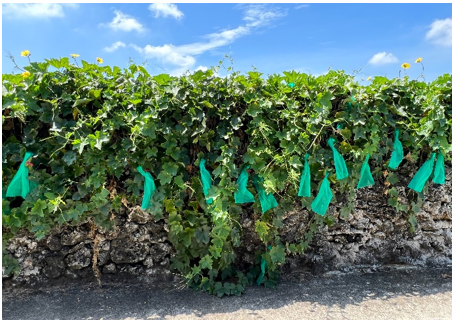
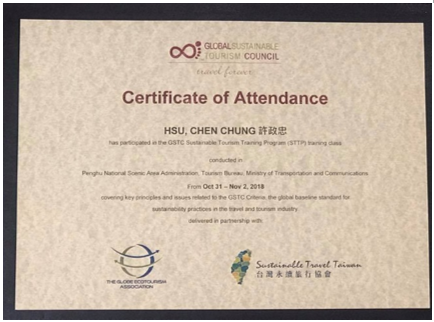
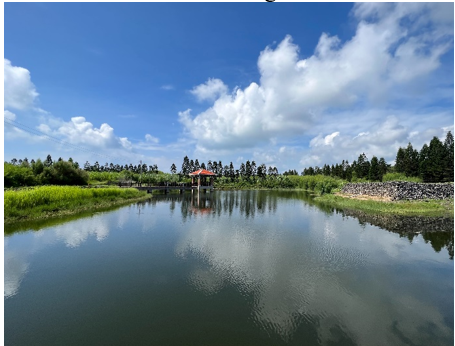
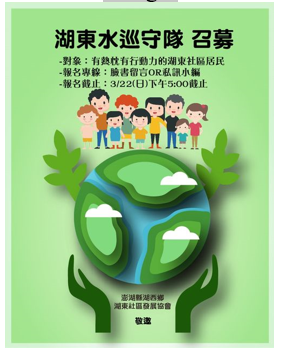
4.3 Conservation of stone weirs and wetland ecology in Hongluo community
A portion of the Hongluo Community falls within the Qingluo Important Wetland, providing residents access to shellfish and other marine life in the Hongluowan Intertidal Zone and stone weirs. During the winter months when open sea fishing is not feasible, fishing within the stone weirs becomes a crucial source of income for the residents. However, advancements in fishing technology, climate changes, and ocean currents have led to a gradual decline in traditional workforce fishing in the stone weirs. As a result, the production value of stone weirs has declined and is now outweighed by its cultural and touristic value. Nevertheless, the intertidal zone and stone weir remain significant to the community’s heritage and a source of pride for its residents.
Penghu has seen significant growth in tourism in recent years, with the government’s support. Fu-Ci Yang, a young Penghu native, has played a vital role in this growth by investing in environmental education and ecological tours. She has tried to preserve local stone weirs and traditions and present the unique characteristics of Hongluo using creative approaches. There is a focus on maintaining the local humanities and landscape conservation while revitalizing the economy through the ecology and natural environments. The biodiversity in the region has become an economic model for the village, combining ecology and production. Income generated from various activities, such as fishing experiences, tours of stone lakes, and intertidal fish, shrimp, and shellfish collection, have contributed significantly to this model. As a result, Hongluo has emerged as a destination for those seeking unique cultural and environmental experiences.
Through the restoration and preservation of stone weirs, young individuals and community residents have undertaken various measures to document the traditional construction methods, record the information on Stone weir groups, identify skilled artisans, and design training programs for young apprentices. In addition, they have implemented educational courses on marine ecology and promoted eco-tourism experiences. A multifaceted service platform has been established to rediscover the marine heritage of the Penghu people and bridge the gap between the younger and older generations. This platform strives to promote community building, cultural preservation, and ecological conservation by setting up demonstration sites and facilitating the sharing of knowledge and expertise. These endeavors are expected to inspire other stone weir communities and enhance the public sector’s perception and handling of these unique ecosystems over time. Collaborative efforts with local pool owners to restore stone lakes will continue to be a crucial component of these initiatives.
It started to restore two stone ports, Xinhu, Tanbian Village, Huxi Township, with a restoration level of 60%, and the outer port The pool with the pool rights is located in Hongluo Village, Huxi Township. Because the outstretched right foot was cut off when the port was built, it collapsed for more than a year. According to the craftsman’s suggestion, the right foot was turned to avoid the port channel, and the restoration degree reached 80%. Afterward, it was observed that a variety of creatures entered pool one after another, including red clams, squid, horseshoe crabs, lionfish, etc. Residents were happy to see the success, and the restoration team felt real accomplishment. In addition to establishing demonstration sites, the stone weir is also used to restore rolling communities, reproduce ecology, and build consensus.
Furthermore, the initiative aims to collaborate with local artists to repurpose old house bases as accommodation and offices for members. These spaces can be used for courses, experiences, and multimedia teaching. The Stone weir technique model, which is not limited by the tide time, can also be taught indoors. This approach provides a comfortable learning environment for experiencers and young artisans to learn the process. Additionally, these spaces can be used to display and sell various products and achievements.


Lessons learned
1. Implementation of a comprehensive system for the preservation, restoration, and revitalization of the stone weir landscape in Penghu
The number of stone weirs in Penghu has exhibited a variable trend over time, as documented by historical records. Specifically, the recorded count stood at 69 in 1915, 314 in 1917, 284 in 1938, 192 in 1957, 558 in 1999 (Hong, 1999), and 592 in 2008 (Li, 2008). According to the publication “Stone Weirs of Penghu”, which appeared in 1988, Huxi Township accounted for 83 stone weirs while the surrounding waters hosted 29. However, a majority of these structures have either been destroyed or sustained partial damage. Presently, the “Penghu Stone Weirs Information Platform” has listed only 60 stone weirs in Huxi Township as of 2021, of which only 23 lie in close proximity to the research area. Hence, the functional significance of stone weirs has shifted from solely serving as fishing apparatus to encompassing multifarious values such as cultural heritage, ecological conservation, eco-tourism, and scenic attraction.
2. Facilitating rural revitalization through youth engagement and cross-sectoral collaboration in Penghu
2.1 A study on the factors influencing the attraction and retention of young people: an analysis of push and pull dynamics
In Penghu, a group of young people has established a youth cooperation platform aimed at promoting marine environmental protection and preserving the local settlement culture. The formation of this platform can be traced along two distinct paths. The first path is driven by young people who, due to the lack of high-quality universities or research institutes in Penghu, must leave the area to pursue their academic goals, either within Taiwan or abroad. A considerable number of these individuals remain overseas for employment opportunities and have yet to return to their hometown. To encourage these students to explore local characteristics and formulate development visions for Penghu, the Soil and Water Conservation Bureau (SWCB) initiated the Migration Program for College Students to Rural Areas. This program aims to raise awareness among students about the cultural and environmental values of Penghu and encourages them to consider returning to or staying in the area. The SWCB remains committed to encouraging young people to participate in various activities that promote environmental protection in Penghu, such as the conservation of stone weirs, intertidal zones, and fish-eating education, as well as the recycling of marine and domestic waste.
The second path towards establishing the youth cooperation platform in Penghu involves young people who were not born in the area but have relocated there for reasons such as pursuing their studies, marrying a local, or simply enjoying the environment. Joining the youth cooperation platform provides these individuals with an opportunity to integrate into local life and culture more easily and to forge relationships with young people of similar ages. Through the exchange of ideas and stimulation of creativity, these individuals can launch new businesses, inherit family businesses, or participate in innovative research and demonstration projects aimed at returning to rural areas as individual or joint venture groups. The youth cooperation platform can assist in securing financial resources during the early stages of entrepreneurship and in developing characteristic industries. The attractive environment of Penghu and the harmonious operation of the youth cooperation platform are the main factors attracting young people to gather in the area. The SWCB’s Youth Returning to Rural Innovation Research Demonstration Project, which is available for both individual and joint venture groups, plays a critical role in empowering young people to start businesses and engage in marine environmental protection and settlement culture preservation. The lack of educational resources in the outlying island remains the primary reason why young people leave Penghu.

2.2 Facilitating a mechanism for youth cooperation in advancing the rural innovation research demonstration project
The SWCB subsidized Penghu youths to engage in innovative research and demonstration projects aimed at revitalizing rural areas. Notable among these initiatives are the efforts of Fu-Ci Yang and Zeng You between 2018 and 2022, which focused on restoring stone weirs, training young restoration craftsmen, promoting environmental education, improving fish stove food spaces, and preserving cultural heritage. Wu Jiarong and Xu Huanyu, also between 2018 and 2022, established fish-eating education bookstores, produced Murloc stories and video records, organized fish-eating education and experience activities, and developed environmental-friendly seafood products to promote fish-eating education. Additionally, Chen Zonghui and Ou Zongyuan established an agricultural and aquatic products sales platform for young people, aimed at promoting the sale and tourism of traceless products. Hong Yuzhen’s work in 2019-2020 involved the use of Penghu plant materials to restore and preserve traditional weaving techniques, promoting weaving culture and the creation of cultural and creative products.
Currently, the Nongyu Haiqing Farmer Cooperation Platform boasts 50 members. The platform facilitates the matching of professional talents across various industries, including fish, stone weir restoration, cultural heritage preservation, and agriculture, for both physical and online sales. The cooperative process provides advantages such as solving the human resource dilemma on outlying islands, peer problem-solving, integration of cross-field expertise to create a complete industrial chain, and a focus on environmental protection, cultural inheritance, social identity, and honor.

2.3 Promoting community development in fishing villages through intergenerational cooperative economic models
The objective of returning youths and community elders is to establish a connection between the ocean and islands through food and agriculture education, thereby driving the development of fishing village industries. Liu Jianrong and the Hudong community have created the “Limited Liability Huxi Township Hudong, Penghu County Community Cooperative” under the brand “Happy Mountain and Sea Flavor”. The cooperative combines traditional agriculture, traditional processing technology, and new product development to promote the agricultural and fishery industry. The cooperative’s primary focus is on cultural inheritance, planning and developing a learning-oriented economic model, which includes cultural guides, cultural inheritance education, ecological experience, environmental education, and launching different itineraries for fishing village environment, living culture, and intertidal ecological experience. Additionally, the cooperative proposes channel planning and establishes a network integration platform for multiple marketing.
The community’s collaboration between the youth and elders is based on their respective strengths. The elders focus on traditional crop and seafood production, fishing, and simple processing, while the youth bring in their knowledge of legal seafood processing methods, packaging design, brand establishment, and sales promotion. The youth are responsible for advertising design, video recording, and online publicity to promote the agricultural and fishery industry, processed products, and eco-tourism in Taiwan and other countries. They establish physical stores and online shopping malls and participate in rural markets. The online platform helps promote outlying islands’ agricultural and fishery products, boosting the community’s and young people’s economic income and creating a win-win outlying island business model.

3. Examining the social impact of SWCB’s efforts to promote sustainable rural development by encouraging youth to return to hometowns
In 2018, the SWCB provided funding to support Fu-Ci Yang’s innovative research demonstration project aimed at encouraging young people to return to rural areas. The project focused on the restoration of Penghu stone weirs and launched a tour experience that utilized traditional local intertidal fishing methods. This tour not only encouraged community residents to participate but also promoted marine education while returning a portion of the tour fees to the communities. Continuous investment in repairing stone weirs will create a sustainable restoration of the Penghu Stone Weir Fund, integrating local resources to develop a new cultural experience in Penghu. The project’s implementation content included a Stone Weir Restoration Matchmaking Mechanism, Stone Weir Young Craftsman Training, Stone Weir Database Consultation, and Stone Weir Marine Education & Ecological Travel. The investigation and recording of 338 stone weirs, covering 718 sq., trained five traditional lecturers and narrators, three young craftsmen, participated in one exhibition, received 12 media exposures, published three research papers on stone weirs, and recorded eight types of Stone Weir restoration methods, among other achievements. Using the Social Return on Investment (Nicholls et al., 2012) methodology, the social impact of the project from February 1, 2017, to August 31, 2018, was reviewed and analyzed from the perspective of stakeholders, with the following results:
3.1 From the perspective of stakeholders
(A) The Ocean Seekers team: The Ocean Seekers team accounts for a high proportion of 24.46% in the overall value of the project results. The highest-valued achievement is the increase in the Ocean Seekers team’s visibility, followed by the fulfillment of self-actualization needs. One of the objectives of this project is to raise awareness of the stone weir issue among more people, and this aspect has also been validated.
(B) Artisan: The highest total value achievement of the Artisan is “obtaining self-actualization needs”, followed by “improving interpersonal relationships and interactions”. The Artisan expressed that through the cooperation with the Sea Urchin Team, they became more confident in themselves and more certain about themselves. From the average value of the influence factor, the Artisan generally believes that there is a very low probability (18%) that these changes would have occurred if they had not come into contact with the Sea Urchin Team. Therefore, for the Artisan, the Sea Urchin Team’s project is unique.
(C) Community residents: The community residents represent the largest beneficiary group, accounting for 29.68% of the total value of the project results. The highest total value achievement for this group is “positive impact on physical and mental health”, followed by “self-actualization needs” and “improving knowledge and restoration skills of stone weirs”. With a high proportion of aging population, Penghu ranks second in the country, so during the implementation of the project, the Seekers team specially invited local community residents to share their daily lives and activities with the participants. This allowed the community residents to feel acknowledged and validated, while the interactive activities made their lives more interesting and gave them a sense of companionship. One of the project’s goals is to evoke memories and emotions related to the ocean among Penghu residents, allowing them to initiate autonomous conservation actions. As a result, most residents became aware of the importance of preserving stone weirs, and even established a team to protect this unique community resource.
(D) Partner organizations: The cooperating organizations are all local organizations in Penghu. Their highest total value achievement is “increased local identity”, followed by “access to resources”. Some members of the cooperating organizations are not local to Penghu. After contact with the Seeking Ocean team, they have a deeper understanding and identification with Penghu. This achievement has influenced the operational direction of the organization, which now focuses more on local Penghu culture. They have even joined forces with other partners who share the same local concerns to strive for related resources and invest in them.
(E) Activity participants – stone weir experience participants: The highest total value achieved by activity participants is “enhancement of marine conservation concepts and knowledge”, followed by “enhancement of stone weir knowledge and restoration skills”. After participating in the Stone Weir Experience and sharing activities with Seeking the Sea People, most activity participants have expressed interest in joining the Seeking the Sea People team for cultural preservation related to stone weirs to promote stone weir preservation. This fully responds to one of the goals of the Seeking the Sea People team’s plan, which is to allow more people to understand and participate in the maintenance of stone weirs.
(F) Scholars: The two highest achievements obtained by expert scholars are “improving teaching quality” and “achieving self-fulfillment needs”.
(G) Youths aspiring to develop in Penghu: Young people who aspire to develop their careers in Penghu constitute a significant beneficiary group, accounting for 25.10% of the total program value. Their two highest gains are “improved knowledge and skills for repairing stone fish weirs” and “increased local identity”. The common thread among these young people is their desire to stay and develop their careers in Penghu. Most of them have expressed that their contact with the Seekers of the Sea team has deepened their understanding and appreciation of Penghu’s culture and stone fish weir resources.
(H) Community where the stone weirs are located: After the restoration of the stone weirs by the Seeking-Hai team, intertidal zones were gradually formed around the weirs, leading to the emergence of various species that had never been seen before in the area. This has increased the ecological diversity of the community and allowed for the sustained observation of environmental benefits. Environmental data will continue to be recorded to facilitate subsequent research and analysis.
(I) Soil and Water Conservation Bureau: The issue of stone weirs that the “Seeking the Sea People” team focuses on belongs to the cultural preservation aspect of the project, which is equivalent to providing the Soil and Water Conservation Bureau with a benchmark case of fisheries culture innovation and a field of examples, accumulating government experience related to fisheries culture. Therefore, when there is a need for a venue or template for reference, the field can be directly borrowed for introduction, becoming an example for others to reference and also increasing the effectiveness of policy promotion. In addition, the “Seeking the Sea People” team’s execution experience has also allowed the Soil and Water Conservation Bureau to adjust policy directions.
3.2 Economic, social, environmental, and governmental level analysis
The analysis results show that the highest proportion is the social aspect, as the main goals of the Seeking Shih’s Fishing Weirs Project are to “establish a platform for Penghu’s stone fishing weirs” and “raise local awareness of marine conservation”. The project has achieved good results in terms of social and cultural benefits (95%). However, long-term operation and development require support from the economic aspect to go far and last. Therefore, in the future, it is necessary to consider how to translate the highly felt social benefits of stakeholders into economic support and investment, so that the issue of preserving the cultural heritage of the stone fishing weirs can continue to ferment. Furthermore, analyzing the multiplier effect of the project’s expenditure, it was found that for every 1 New Taiwan dollar invested in the Seeking Shih’s Fishing Weirs Project, it will create approximately 24.69 New Taiwan dollars of social value. However, this analysis also found that the environmental impact of the stone fishing weirs was underestimated, with an impact amount of only 30,840 New Taiwan dollars, accounting for only 0.04% of the total impact. The main reason for this is that most stakeholders consider the stone fishing weirs as a site for cultural heritage, ecological education, and tourism, and did not calculate or consider the ecological value of the stone fishing weirs’ biotope, fishing yield, wetlands, or intertidal zone.
The evaluation of the social impact of this project was conducted in 2019, and this study further observes and compares the trend of changes from 2020 to 2022. It was found that various stakeholders, including the Soil and Water Conservation Bureau and scholars, continue to assist young people in developing in Penghu, leading to a gradual increase in the number of young people interested in Penghu. The social, economic, and environmental impact of the intertidal zone in Penghu has also continued to increase. The economic, social, and environmental impact of the team, cooperating organizations, craftsmen, the community where the stone weirs are located, and the community residents have all shown a significant increase in trend. Moreover, the number of stone weir experience participants interested in participating in stone weir restoration, engaging in ecological experiences and tourism, and intertidal zone environmental education has also shown a trend of year-on-year increase. Overall, the Soil and Water Conservation Bureau’s guidance for young people in stone weir restoration and ecological habitat protection has a long-term positive effect on the economic, social, and environmental impact driven by the intertidal zone in the study area.
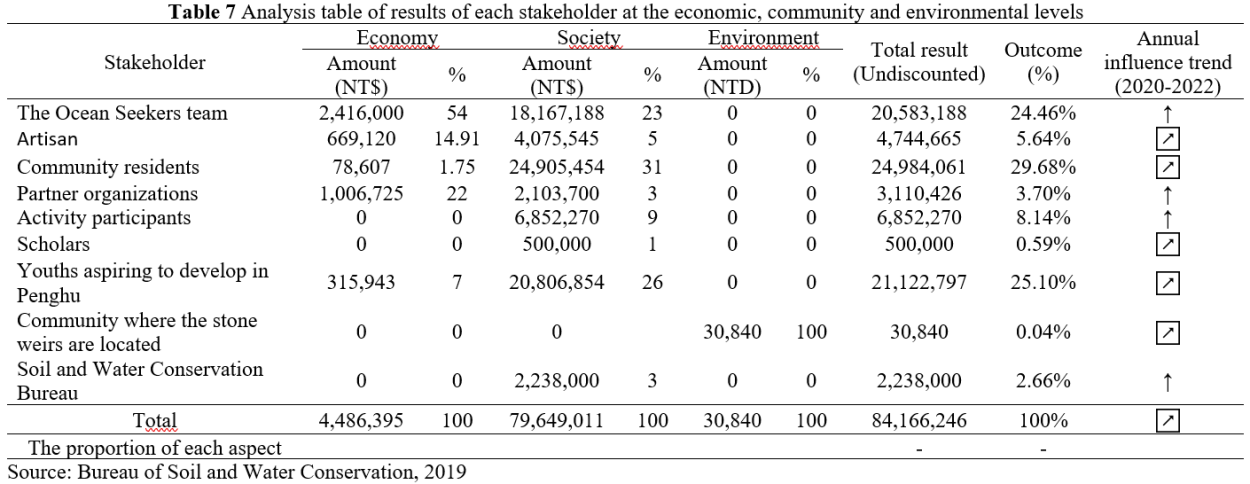
Key messages
- Stone weirs along the coast of Penghu Island play important and diverse ecosystem service functions in the intertidal zone and are closely related to the livelihoods of fishing villages. They are important areas for positive interaction between islanders and nature.
- The youth guidance policy of the Soil and Water Conservation Bureau effectively guides island youth to engage in intertidal and stone weir environmental protection, as well as fishing village environmental conservation and tourism development, which has a positive impact on maintaining the ecological, economic, and social landscape of the island’s intertidal zone.
- Youth clusters and cooperation platforms, which bring together a shared awareness of marine ecological conservation and traditional cultural heritage, and promote cross-disciplinary cooperation, can accelerate the realization of ideal intertidal and stone weir protection by young people.
- The preservation of the coastal landscape in the intertidal zone of Penghu can be simultaneously promoted from ecological, economic, social, and cultural perspectives. Therefore, the establishment of cross-domain cooperation mechanisms is helpful for the sustainable use of Penghu’s intertidal zone and stone weirs.
References
- Penghu County Government (2023). Introduction. Retrieved March 07, 2023 from https://www.penghu.gov.tw/en/home.jsp?id=6
- Hong, G.-X. (1999). Stone Lake in Penghu. National Central Library. Retrieved March 07, 2023 from https://tm.ncl.edu.tw/
- Li, M.-R. (2008). Digital Archives – Forms and Culture of Stone Weir in Penghu.
- National Penghu University of Science and Technology (2016). Formulation of the report on the results of the green snail wetland conservation and utilization plan.
- Nicholls, J., Lawlor, E., Neitzert, E., & Goodspeed, T. (2012). A guide to Social Return on Investment. Social Value Lab.
- Wu, P.-Q. (2021). Caspian Spirit and Connotation Analysis of Stone Weir Community, Jibei Island, Penghu National Taiwan Normal University. Taiwan.
- Yang, F.-C. (2021). Leaving the island and leaving the studio. “Seeking Sea People Looking for Pools”. Years of 2018, 2019, and 2020 of youth returning to rural innovation research projects.

